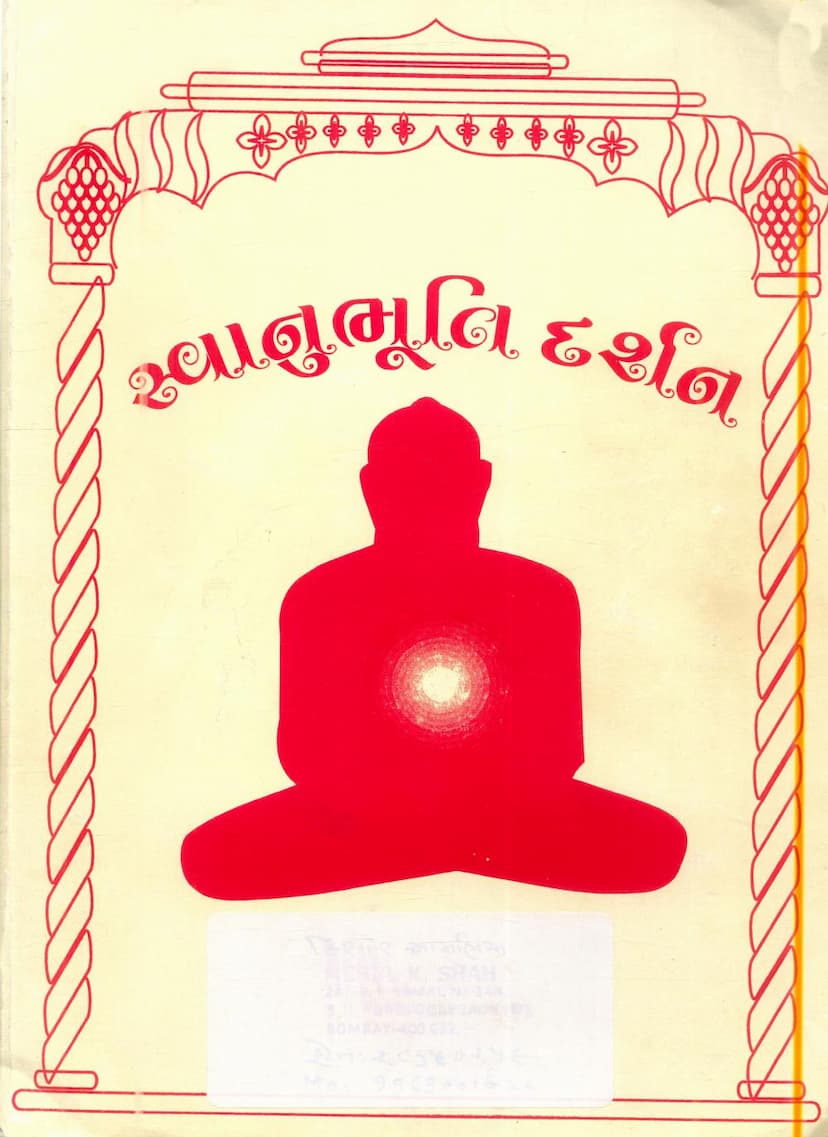Swanubhuti Darshan
Added to library: September 2, 2025

Summary
Here's a comprehensive summary of the Jain text "Swanubhuti Darshan" by Ramniklal Savla, based on the provided PDF pages:
Title: Swanubhuti Darshan (Vision of Self-Realization) Author/Compiler: Ramniklal Savla Publisher: Ramniklal Savla Purpose: For personal study only.
Core Message and Theme:
The text "Swanubhuti Darshan" is a profound exploration of Jain philosophy, particularly focusing on the path to self-realization and liberation (Moksha) as taught by the omniscient Tirthankaras and elucidated by great Jain Acharyas. The central theme revolves around understanding the true nature of the soul (Atma), its inherent qualities, and the practical steps towards experiencing its pure, liberated state. The book emphasizes the principles of Anekantavada (non-absolutism), Syadvada (conditional predication), and the ultimate goal of achieving Vitraagta (dispassionateness) and Kevala Gnana (omniscience).
Key Concepts and Principles:
-
Nature of the Soul (Atma):
- The soul is described as the true self, characterized by infinite knowledge, perception, power, and bliss. It is inherently pure, formless, eternal, and unchangeable in its essence.
- The soul is distinct from the body, karma, and all other substances (dravyas). It is the knower (Gyayak) and the perceiver (Drashta) of all phenomena, both internal and external, without being affected by them.
- The soul's true nature is described as pure consciousness, bliss, and omniscient, unconditioned by worldly interactions or transformations.
-
Distinction between Substance (Dravya) and Its Modifications (Paryaya):
- The text strongly emphasizes the eternal, unchanging nature of the soul-substance (Dravya) versus the transient, ever-changing modifications (Paryaya) of the soul.
- True realization (Swanubhuti) comes from focusing on the eternal substance (Dravya) and understanding that the soul is not its temporary states or modifications.
-
Prakriti and Vikriti:
- The soul's true nature (Prakriti) is pure, blissful, and omniscient.
- Vikritis are the soul's modifications or states, such as attachment, aversion, anger, ego, delusion, and the impact of karma. These are considered impure and a cause of bondage and suffering.
- The path to liberation involves recognizing the difference between the pure soul and these impure modifications, and detaching from the latter.
-
The Path to Liberation (Moksha):
- Right Faith (Samyak Darshan), Right Knowledge (Samyak Gnana), and Right Conduct (Samyak Charitra): These three jewels (Ratnatraya) are presented as the essential path to liberation.
- Swanubhuti (Self-Realization): This is the direct experience of the soul's true nature. It is achieved through sustained focus, introspection, and dispassionateness.
- Bhed Gnana (Discernment): Understanding the fundamental difference between the soul (Jiva) and non-soul (Ajiva) substances is crucial. This involves discerning the soul from the body, senses, mind, emotions, karma, and all external phenomena.
- Detachment from External and Internal Objects: True liberation involves transcending attachment to both external material objects and internal states of mind like attachment, aversion, anger, pride, illusion, greed, etc.
- Vitragta (Dispassionateness): This is the ultimate goal and the essence of Jainism. It's the state of being free from the influence of passions and external conditions.
- The Role of the Guru: The text highlights the importance of a spiritual guide (Guru) who has attained self-realization to guide the seeker.
-
Key Jain Principles Explained:
- Pancha Mahavratas (Five Great Vows): Ahimsa (non-violence), Satya (truth), Asteya (non-stealing), Brahmacharya (celibacy), and Aparigraha (non-possession) are explained not just as external actions but as internal states of being and the inherent nature of the soul.
- Anekantavada: The principle of manifold viewpoints is implicitly present, encouraging a nuanced understanding of reality.
- Pancha Samvay (Five Factors of Causation): The interaction of Svabhava (one's own nature), Niyati (destiny), Kalalabdhi (time), Nimitta (circumstances/instrumental cause), and Purushartha (effort) is discussed in relation to spiritual progress and the manifestation of soul's inherent qualities.
-
Practical Guidance:
- The book provides a step-by-step approach to spiritual practice, emphasizing:
- Patrata (Worthiness/Eligibility): Cultivating detachment, control over senses, and a genuine desire for liberation.
- Abhyas (Practice): Regular self-study, listening to preachings, contemplation, and association with the wise (Satsang).
- Yatharth Nirnay (Right Determination): Correct understanding of soul-substance based on scripture and reasoning.
- Bhed Gnana (Discernment): Deep contemplation to differentiate the soul from non-soul entities.
- Anubhuti (Experience/Realization): The ultimate goal is the direct, lived experience of the soul's nature.
- The book provides a step-by-step approach to spiritual practice, emphasizing:
Overall Tone and Style:
The text is deeply philosophical and devotional, drawing heavily on the teachings of prominent Jain Acharyas like Kundkundacharya and ultimately aiming to guide the reader towards an experiential understanding of the soul. It uses a language that is both profound and accessible, with repeated emphasis on introspection, self-effort, and the ultimate supremacy of the soul's own nature. The repeated phrases and concepts underscore the core message: the soul is the ultimate reality and the source of true happiness and liberation.
Summary of the Content Progression:
The book seems to progress from establishing the fundamental principles of Jain philosophy (like the nature of soul, karma, and reality) through the meticulous explanation of the spiritual path. It delves into the practical aspects of Sadhana, the importance of right perception and knowledge, and the role of detachment. The text repeatedly guides the reader inward, emphasizing that the answers and the ultimate realization lie within the self. It breaks down the process into stages, from initial understanding to deep contemplation and finally to the direct experience of the soul. The explanations often use analogies and direct questioning to stimulate the reader's own inquiry and realization.
Key Takeaway:
"Swanubhuti Darshan" is a guide to understanding and experiencing the Jain path to spiritual liberation. It advocates for deep self-inquiry, the discernment of the true self from the non-self, and the cultivation of dispassionateness through consistent spiritual practice, ultimately leading to the direct experience of the soul's pure, liberated state.